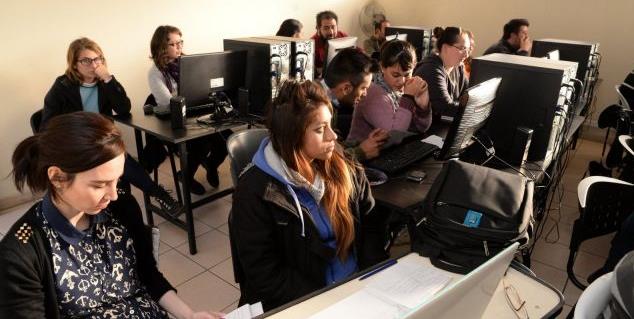
Will Colombia’s New President Deliver on His Promises?
Iván Duque, a conservative former senator, on Sunday won Colombia’s presidential runoff election. What does it mean for the country?
A Daily Publication of The Dialogue
Argentina’s government on Aug. 9 launched the second phase of its “Argentina Programs” plan, which aims to provide training in computer programming to 60,000 youths by the end of this year. The program follows another initiative that the government launched in July to add 50,000 people between the ages of 18 and 24 to the work force. In Argentina and elsewhere in Latin America, how much has youth employment suffered during the pandemic? What are the most important components of government and private-sector programs to lower unemployment levels among young people? How much growth will technology-industry jobs see in the coming years in Latin America, and what should governments be doing to provide young people with the skills to fill them?
Alicia Bárcena, executive secretary of the United Nations Economic Commission for Latin America and the Caribbean: “The pandemic has had an unprecedented economic impact on Latin American and Caribbean labor markets. Although efforts to contain the health crisis have had economic repercussions worldwide, the region has been hit harder than other parts of the world. The 6.8 percent decline in GDP translated to a sharp drop in employment and labor force participation and to a 2.1 percentage point increase in the regional unemployment rate, reaching 10.5 percent in 2020. Job losses affect women and young people to a greater extent, essentially as a result of: 1.) a large-scale withdrawal of women from the labor market, caused both by mobility restrictions and by fewer employment alternatives, compounded by household care needs; and 2.) the significant decrease in informal jobs, in which 68.5 percent of young workers in the region are employed. Consequently, the youth participation rate in the labor market dropped by five percentage points, and the youth employment rate fell to 32.7 percent. The crisis has also severely hindered the school-to-work transition of youth. Those in training and in work-based learning have faced disruptions in their education process. New entrants to the labor market have confronted a scenario with limited job creation and a lack of opportunity, whereas those already in the labor market were hit by job and income losses. By the end of 2020, the unemployment rate of youths reached 23 percent (around seven million young people). The region also faces a substantial problem of underutilization of youth labor, when also considering young people who are not seeking jobs because of a perceived lack of suitable employment and those who want to work more hours but are unable to find full-time jobs. Policy responses must prevent the worsening of existing inequalities and must place an emphasis on women and young people, those informally employed and other strongly affected groups, such as young women and young migrant workers. Labor programs for young people should link supply policies (such as training and skills development and elimination of economic, social and cultural barriers) with demand policies, involving the private sector and with strong inter-institutional coordination.”
Richard Delgado, director of Oracle Academy Latin America, and Diogo Brunacci, director of public affairs at Oracle Latin America: “The Covid-19 pandemic has demonstrated a clear need for governments to provide assistance and support, even as they faced massive new challenges: a remote work force, a vast increase in online engagement, an education system forced to adapt to remote learning and overwhelmed public health and first-responder resources. It has become even more clear that the delivery of citizen services must be more efficient and more flexible—and digital transformation is even more imperative, in a context where stresses on public infrastructure and resources drive demand for greater efficiency and resiliency. By 2024, several studies forecast that Latin America will need more than 500,000 professionals across all industries, including more than 400,000 in information and communications technology. This shows the need to train qualified workers in the short term. For example, Brazilian schools graduate around 46,000 people from technical programs every year. Latin American countries will have to face this skills shortage not only as a priority, but as a strategy for growth. In this context, countries will need to fight back and create their own strategies to address this skills gap, as Argentina is doing with the Argentina Programs plan. This is a great opportunity for Latin American countries, especially at a time when the unemployment rate has gone from 10 percent to 20 percent. Schools should educate students on the development of web pages in Java and on Android mobile environments and iOS, among others, so that their skills match up with the demand in the job market. In this sense, governments should consider prioritizing the requalification of courses to adjust to the demands of the labor market. It is important to focus the orientation on practice, with training sessions and simulations on real-world demand in order to always set up measures to ensure diversity and include all of the population in this movement.”
Mariana Costa, co-founder and CEO of Laboratoria: “The pandemic has hit young adults hard in Latin America, with millions of students dropping out of higher education due to economic hardship to face a job market with limited skills and experience under their belts. This has reinforced the condition of unemployment or precarious employment for the vast majority of Latin America’s youth, which means less human capital accumulation for those who represent our future. Given this situation, many governments are shifting to support shorter, practical reskilling programs for the digital age, where demand for talent continues to surge, driven by the region’s digital transformation. Undoubtedly, this is a shift in the right direction as boot camp programs and the like tend to offer skilling paths that are well-connected to market demand, remote and much less costly than traditional higher education. There are, however, important considerations if governments want the resources invested to yield solid results. First, governments should partner with education players that can guarantee certain quality standards and job placement outcomes. It won’t be of much help to train thousands of developers if they end up jobless because their education was not pertinent. Second, the private sector should be an active partner in this effort, committing to flexibilize hiring policies (for example, by dropping the higher education requirement for certain roles) and to open doors for junior talent. Finally, governments should encourage the growth of the digital economy and its strength as an employer through flexible work regulations and attractive policies for global companies that want to set foot in the region.”
Vinicius Pinheiro, assistant director general and regional director for Latin America and the Caribbean at the International Labor Organization: "The disproportionate impact of the pandemic on youth triggered a time bomb that could affect social and political stability in Latin America. The components of this explosive mix include unemployment, informality and unprecedented reductions in labor force participation among the 15-24-year-old population. In Argentina, youth employment decreased by approximately 40 percent during the first half of 2020. Youth continues to lack access to quality education due to school closures and because of a lack of proper infrastructure, including connectivity. Among the most vulnerable are young women, migrants and informal workers—six out of 10 young people in the labor force work in informal jobs. Argentina’s government has been responding to the youth employment crisis with a focus on education, professional training and labor insertion programs. Most recently, the Ministry of Labor launched a nationwide digital platform to facilitate job placement, skills matching and access to information for promoting employment and training. Going forward, a set of larger-scale and targeted employment policies designed to face the complex structural issues will be necessary for Argentina to generate decent work opportunities and to prevent greater youth exclusion. Expansion of support to youth-led micro, small and medium enterprises as well as entrepreneurs is essential while promoting education and training in a way that responds to the current and future needs of the labor market. The lack of youth employment opportunities is worrisome as it affects future career paths. Young people face the risk of becoming a ‘lockdown generation.’ ”
 The Latin America Advisor features Q&A from leaders in politics, economics, and finance every business day. It is available to members of the Dialogue’s Corporate Program and others by subscription.
The Latin America Advisor features Q&A from leaders in politics, economics, and finance every business day. It is available to members of the Dialogue’s Corporate Program and others by subscription.
Iván Duque, a conservative former senator, on Sunday won Colombia’s presidential runoff election. What does it mean for the country?
Mexicans go to the polls on Sunday, July 1, for the country’s presidential, legislative and local elections. What can we expect?
Leftist Andrés Manuel López Obrador swept to victory Sunday in Mexico. What changes are in store?
 Job losses during the pandemic have hit young people especially hard. Students in a technology training program in Argentina are pictured before the pandemic. // File Photo: Argentine Government.
Job losses during the pandemic have hit young people especially hard. Students in a technology training program in Argentina are pictured before the pandemic. // File Photo: Argentine Government.

